Extending Swagger and Springdoc Open API
Learn how to use Swagger schema extensions, and document additional constraints that would otherwise remain undocumented, including custom validators.
Join the DZone community and get the full member experience.
Join For FreeJava adoption has shifted from version 1.8 to at least Java 17. Concurrently, Spring Boot has advanced from version 2.x to 3.2.2. The springdoc project has transitioned from the older library 'springdoc-openapi-ui' to 'springdoc-openapi-starter-webmvc-ui' for its functionality. These updates mean that readers relying on older articles may find themselves years behind in these technologies. The author has updated this article so that readers are using the latest versions and don't struggle with outdated information during migration.
In my last recent articles — OpenAPI 3 Documentation With Spring Boot and Doing More With Springdoc OpenAPI — we tried out a Spring Boot Open API 3-enabled REST project and explored some of its capabilities, namely:
- Automatic JSR-303-related Swagger documentation
- How Maven builds properties could be shown as project information in the Swagger documentation
- Rendering fully qualified names in the generated Swagger documentation
- Global exception handling using Controller Advice and its related Swagger documentation
We also discussed how in future releases of springdoc-openapi:
- Achieving FQNs can be a lot easier (since achieved).
- springdoc-openapi will handle
@ControlerAdvicerelated documentation in an even better manner with more flexibility (since achieved).
Previously, amongst other details, we saw how we were able to leverage some of the JSR 303 annotations. We did notice some annotations were being ignored; e.g., javax.validation.constraints.Email and org.hibernate.validator.constraints.CreditCardNumber.
New Objective
Having detailed contracts specified for input and output would be very important for any API. Wouldn't it be nice if we could extend Swagger's behavior and communicate via its automated documentation the information regarding these additional annotations and also custom validation annotations?
Let's explore that. Let's keep the code as simple as possible. We will start from scratch and write enough code to achieve our objective.
We won't be repeating the exception handling and Controller Advice concepts already detailed the last time (just to keep this article's code as simple as possible).
As before, we are going to refer to Building a RESTful Web Service and springdoc-openapi v2.5.0.
I would also like to thank Badr Nass Lahsen of Springdoc for reviewing the article and code.
Prerequisites
- Java 17.x
- Maven 3.x
- Lombok installed in the IDE (if using an IDE)
Steps
Start by creating a Maven JAR project. Below, you will see the pom.xml to use:
<?xml version="1.0" encoding="UTF-8"?>
<project xmlns:xsi="http://www.w3.org/2001/XMLSchema-instance"
xmlns="http://maven.apache.org/POM/4.0.0"
xsi:schemaLocation="http://maven.apache.org/POM/4.0.0 https://maven.apache.org/xsd/maven-4.0.0.xsd">
<modelVersion>4.0.0</modelVersion>
<parent>
<groupId>org.springframework.boot</groupId>
<artifactId>spring-boot-starter-parent</artifactId>
<version>3.2.2</version>
<relativePath ></relativePath> <!-- lookup parent from repository -->
</parent>
<groupId>com.example</groupId>
<artifactId>sample</artifactId>
<version>0.0.1</version>
<name>sample</name>
<description>Demo project for Spring Boot with openapi 3 documentation</description>
<properties>
<java.version>17</java.version>
</properties>
<dependencies>
<dependency>
<groupId>org.springframework.boot</groupId>
<artifactId>spring-boot-starter-web</artifactId>
</dependency>
<dependency>
<groupId>org.springframework.boot</groupId>
<artifactId>spring-boot-starter-validation</artifactId>
</dependency>
<dependency>
<groupId>org.springdoc</groupId>
<artifactId>springdoc-openapi-starter-webmvc-ui</artifactId>
<version>2.5.0</version>
</dependency>
<dependency>
<groupId>org.projectlombok</groupId>
<artifactId>lombok</artifactId>
</dependency>
</dependencies>
<build>
<plugins>
<plugin>
<groupId>org.springframework.boot</groupId>
<artifactId>spring-boot-maven-plugin</artifactId>
</plugin>
</plugins>
</build>
</project>Note the "springdoc-openapi-starter-webmvc-ui" dependency.
If using the Eclipse IDE, we might need to do a Maven update on the project (right-click on Project - Maven > Update Project) after creating the pom.xml with the content above.
Now, let's create a small Java bean class similar to previous articles.
package sample.model;
import jakarta.validation.constraints.Email;
import jakarta.validation.constraints.Max;
import jakarta.validation.constraints.Min;
import jakarta.validation.constraints.NotBlank;
import jakarta.validation.constraints.NotNull;
import jakarta.validation.constraints.Pattern;
import jakarta.validation.constraints.Size;
import jakarta.xml.bind.annotation.XmlAccessType;
import jakarta.xml.bind.annotation.XmlAccessorType;
import jakarta.xml.bind.annotation.XmlRootElement;
import lombok.Data;
import org.hibernate.validator.constraints.CreditCardNumber;
import sample.customvalidations.DateTimeType;
import sample.customvalidations.LocalDateTimeFormat;
@Data
@XmlRootElement(name = "person")
@XmlAccessorType(XmlAccessType.FIELD)
public class Person {
private long id;
@Size(min = 2)
private String firstName;
@NotNull
@NotBlank
private String lastName;
@Pattern(regexp = ".+@.+\\..+", message = "Please provide a valid email address")
private String email;
@Email()
private String email1;
@Min(18)
@Max(30)
private int age;
@CreditCardNumber
private String creditCardNumber;
@LocalDateTimeFormat(pattern = "yyyyMMdd", dateTimeType = DateTimeType.Date, message = "Invalid dateTimeField Format. It Should be in yyyyMMdd format")
private String registrationDate;
}
Person.java might complain about sample.customvalidations.DateTimeType and sample.customvalidations.LocalDateTimeFormat. We will add those classes later as we proceed with the steps.
This is an example of a Java bean. This Java bean also now contains an additional "registrationDate" field just to demonstrate custom validators.
Now, let's create a controller.
package sample.controller;
import jakarta.validation.Valid;
import sample.model.Person;
import org.springframework.http.MediaType;
import org.springframework.web.bind.annotation.PostMapping;
import org.springframework.web.bind.annotation.RequestBody;
import org.springframework.web.bind.annotation.RestController;
import io.swagger.v3.oas.annotations.media.Content;
import io.swagger.v3.oas.annotations.media.ExampleObject;
@RestController
public class PersonController {
@PostMapping(path = "/person", consumes = { MediaType.APPLICATION_JSON_VALUE,
MediaType.APPLICATION_XML_VALUE })
@io.swagger.v3.oas.annotations.parameters.RequestBody(required = true, content = @Content(examples = {
@ExampleObject(value = INVALID_REQUEST, name = "invalidRequest", description = "Invalid Request"),
@ExampleObject(value = VALID_REQUEST, name = "validRequest", description = "Valid Request") }))
public Person person(@Valid @RequestBody Person person) {
return person;
}
private static final String VALID_REQUEST = """
{
"id": 0,
"firstName": "string",
"lastName": "string",
"email": "abc@abc.com",
"email1": "abc@abc.com",
"age": 20,
"creditCardNumber": "4111111111111111",
"registrationDate": "20211231"
}""";
private static final String INVALID_REQUEST = """
{
"id": 0,
"firstName": "string",
"lastName": "string",
"email": "abcabc.com",
"email1": "abcabc.com",
"age": 17,
"creditCardNumber": "411111111111111",
"registrationDate": "string"
}""";
}
Let's make some entries in src\main\resources\application.properties. Please create the file accordingly.
application-description=@project.description@
application-version=@project.version@
springdoc.swagger-ui.show-extensions=true
springdoc.swagger-ui.show-common-extensions=true
server.error.include-message=always
server.error.include-binding-errors=always
springdoc.use-fqn=trueThe application-description and application-version entries will pass on Maven build-related information to the OpenAPI documentation.
package sample.config;
import io.swagger.v3.oas.models.OpenAPI;
import io.swagger.v3.oas.models.info.Info;
import io.swagger.v3.oas.models.info.License;
import org.springframework.beans.factory.annotation.Value;
import org.springframework.context.annotation.Bean;
import org.springframework.context.annotation.Configuration;
@Configuration
class OpenApiConfig {
@Bean
public OpenAPI customOpenAPI(@Value("${application-description}") String appDesciption,
@Value("${application-version}") String appVersion) {
return new OpenAPI()
.info(new Info()
.title("sample application API")
.version(appVersion)
.description(appDesciption)
.termsOfService("http://swagger.io/terms/")
.license(new License().name("Apache 2.0")
.url("http://springdoc.org")));
}
}
Let's write the Spring Boot application class.
package sample;
import org.springframework.boot.SpringApplication;
import org.springframework.boot.autoconfigure.SpringBootApplication;
@SpringBootApplication
public class SampleApplication {
public static void main(String[] args) {
SpringApplication.run(SampleApplication.class, args);
}
}Let's add some more code to help demonstrate custom validators.
package sample.customvalidations;
public enum DateTimeType {
DateTime,
Date,
Time
}
package sample.customvalidations;
import java.lang.annotation.Documented;
import java.lang.annotation.ElementType;
import java.lang.annotation.Retention;
import java.lang.annotation.Target;
import jakarta.validation.Constraint;
import jakarta.validation.Payload;
import static java.lang.annotation.RetentionPolicy.RUNTIME;
@Target({ ElementType.FIELD, ElementType.METHOD, ElementType.PARAMETER,
ElementType.ANNOTATION_TYPE })
@Retention(RUNTIME)
@Constraint(validatedBy = LocalDateTimeValidator.class)
@Documented
public @interface LocalDateTimeFormat {
String message() default "{message.key}";
Class<?>[] groups() default {};
Class<? extends Payload>[] payload() default {};
String pattern();
DateTimeType dateTimeType() default DateTimeType.DateTime;
}package sample.customvalidations;
import java.time.LocalDate;
import java.time.LocalDateTime;
import java.time.LocalTime;
import java.time.format.DateTimeFormatter;
import javax.validation.ConstraintValidator;
import javax.validation.ConstraintValidatorContext;
public class LocalDateTimeValidator implements ConstraintValidator<LocalDateTimeFormat, String> {
private String pattern;
private DateTimeType dateTimeType;
@Override
public void initialize(LocalDateTimeFormat constraintAnnotation) {
this.pattern = constraintAnnotation.pattern();
this.dateTimeType = constraintAnnotation.dateTimeType();
}
@Override
public boolean isValid(String object, ConstraintValidatorContext constraintContext) {
if (object == null || "".equals(object)) {
return true;
}
try {
DateTimeFormatter dateFormatter = DateTimeFormatter.ofPattern(pattern);
if (DateTimeType.Time.equals(dateTimeType)) {
LocalTime.parse(object, dateFormatter);
}
else if (DateTimeType.Date.equals(dateTimeType)) {
LocalDate.parse(object, dateFormatter);
}
else {
LocalDateTime.parse(object, dateFormatter);
}
return true;
}
catch (Exception e) {
// e.printStackTrace();
return false;
}
}
}At this stage, this is what the project looks like in Eclipse:

Above are the project contents. Next, execute the mvn clean package from the command prompt or terminal. Then, execute java -jar target\sample-0.0.1.jar.
You can also launch the application by running the SampleApplication.java class from your IDE.
Now, let's visit the Swagger UI — http://localhost:8080/swagger-ui.html:
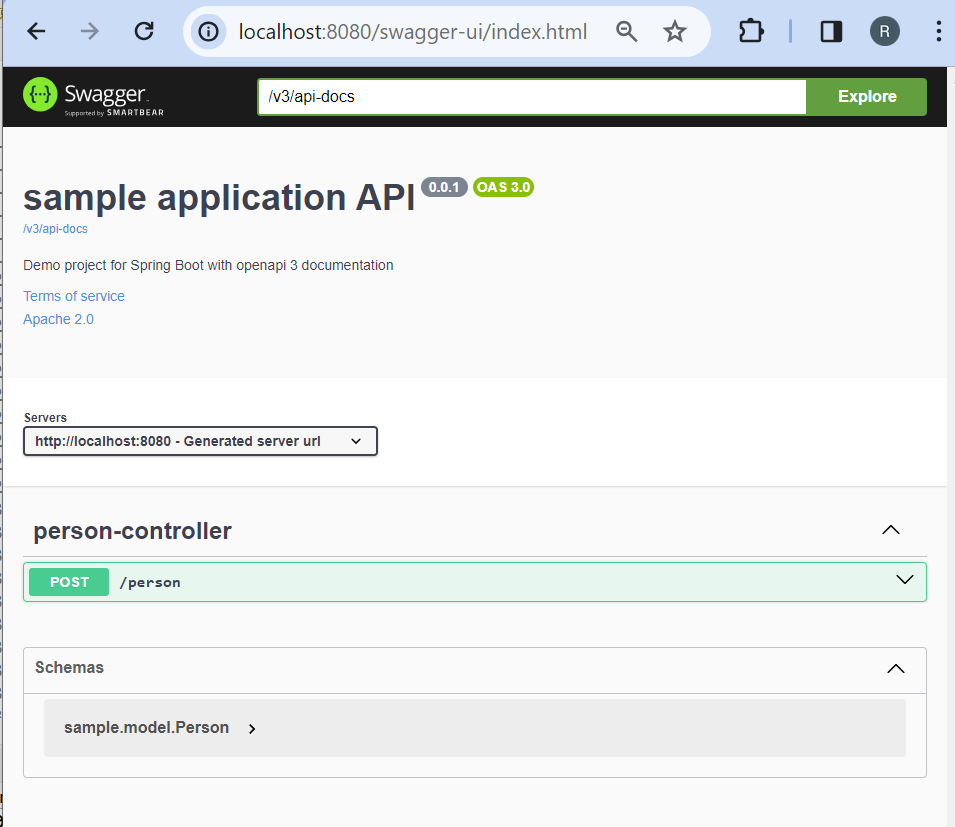
Expand the > symbol on the right of Person under Schemas. Expand the various properties also.
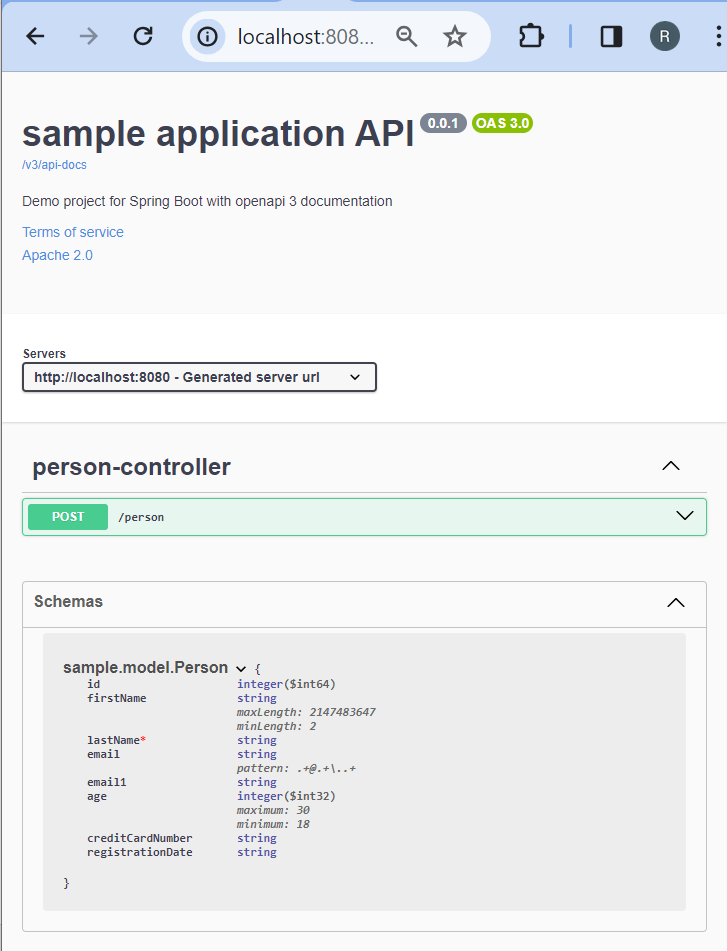
The nice thing is how the contract is automatically detailed leveraging JSR-303 annotations on the model. Out-of-the-box, it covers many of the important annotations and documents them. However, I do not see it support @javax.validation.constraints.Email and @org.hibernate.validator.constraints.CreditCardNumber out-of-the-box at this point.
Nor does it support our custom annotation which we applied to the registrationDate field in the Person Java bean.
@LocalDateTimeFormat(pattern = "yyyyMMdd", dateTimeType=DateTimeType.Date,
message = "Invalid dateTimeField Format. It Should be in yyyyMMdd format")
private String registrationDate;However, these constraints are being applied by the back end.
For completeness, let's post a request. Press the POST button. Then press the Try it out button that will appear. That will lead you to the screen below.
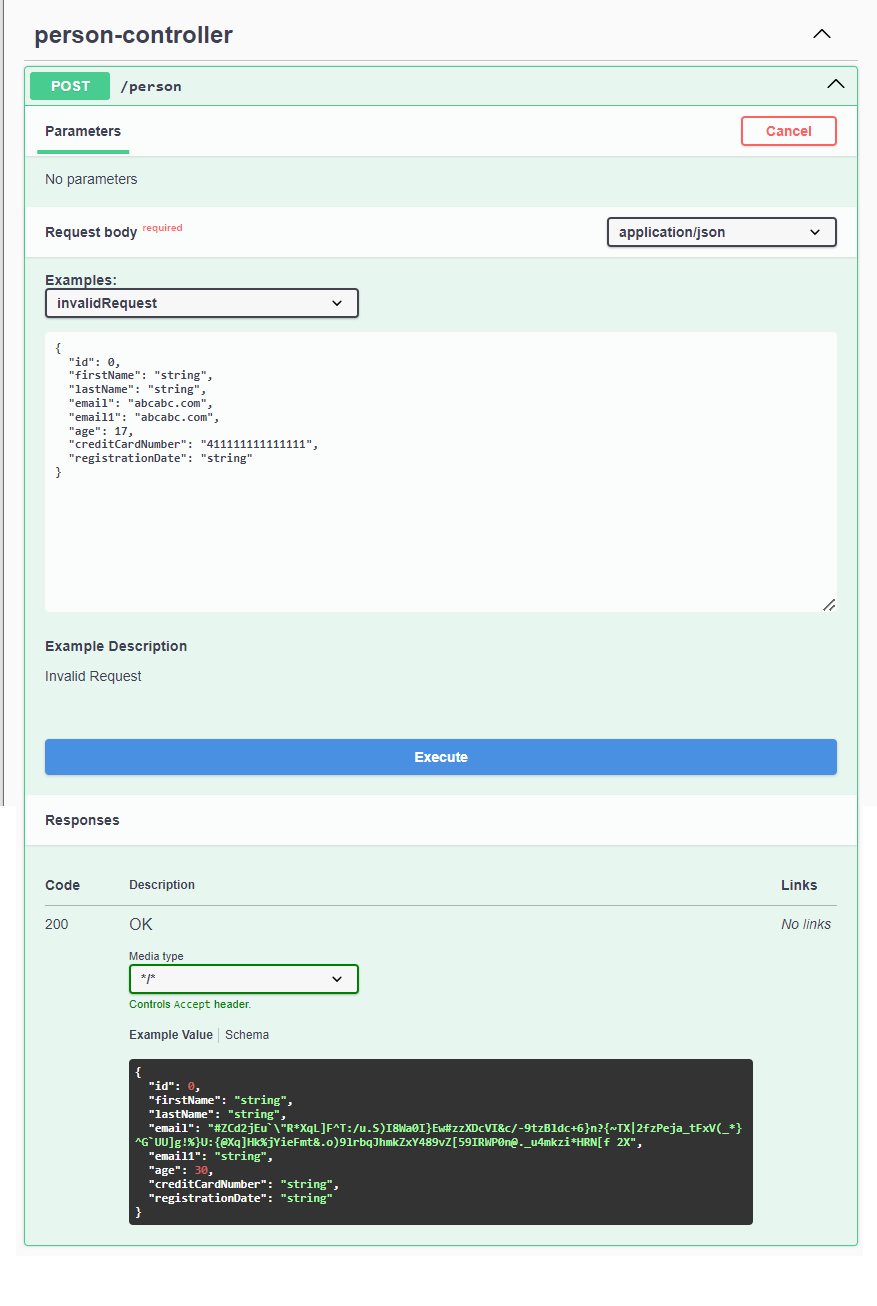
Press the blue Execute button.
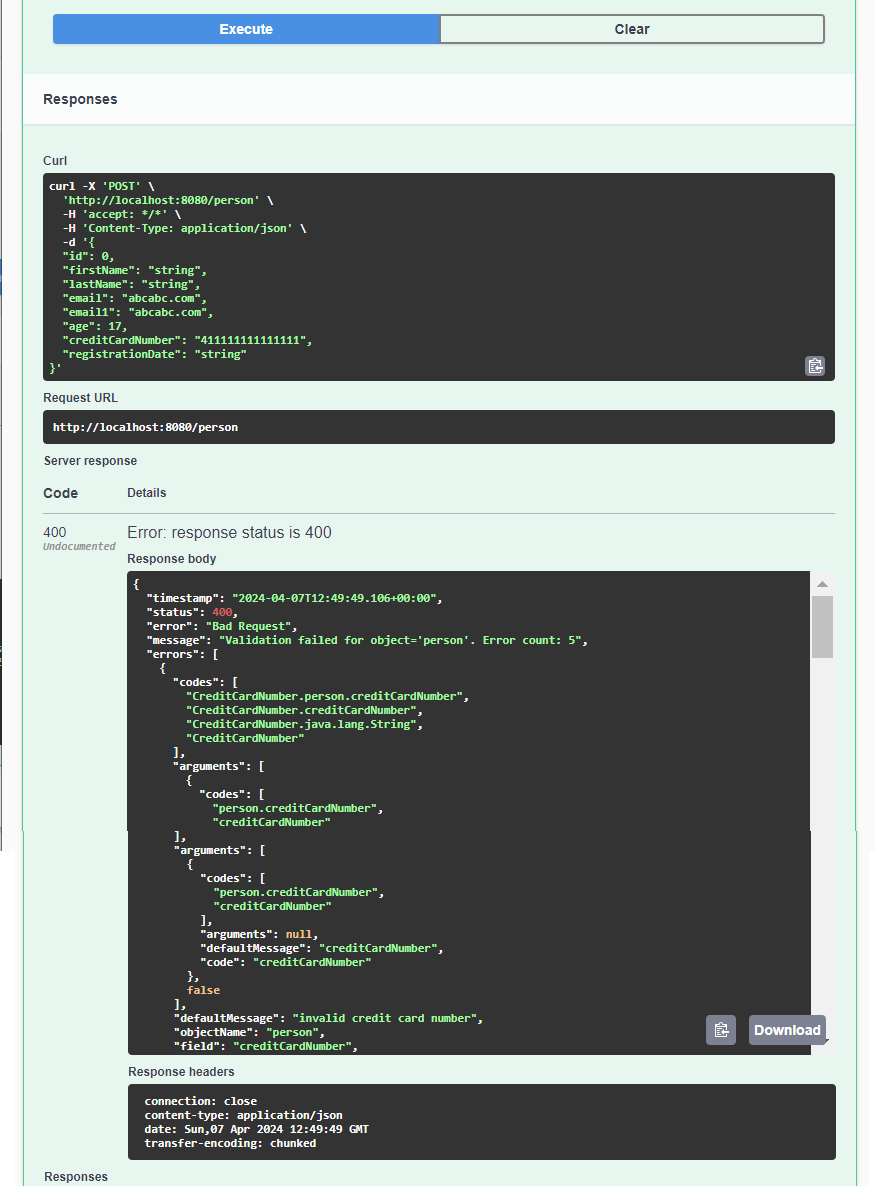
{
"timestamp": "2024-04-07T12:49:49.106+00:00",
"status": 400,
"error": "Bad Request",
"message": "Validation failed for object='person'. Error count: 5",
"errors": [
{
"codes": [
"CreditCardNumber.person.creditCardNumber",
"CreditCardNumber.creditCardNumber",
"CreditCardNumber.java.lang.String",
"CreditCardNumber"
],
"arguments": [
{
"codes": [
"person.creditCardNumber",
"creditCardNumber"
],
"arguments": null,
"defaultMessage": "creditCardNumber",
"code": "creditCardNumber"
},
false
],
"defaultMessage": "invalid credit card number",
"objectName": "person",
"field": "creditCardNumber",
"rejectedValue": "411111111111111",
"bindingFailure": false,
"code": "CreditCardNumber"
},
{
"codes": [
"LocalDateTimeFormat.person.registrationDate",
"LocalDateTimeFormat.registrationDate",
"LocalDateTimeFormat.java.lang.String",
"LocalDateTimeFormat"
],
"arguments": [
{
"codes": [
"person.registrationDate",
"registrationDate"
],
"arguments": null,
"defaultMessage": "registrationDate",
"code": "registrationDate"
},
"Date",
{
"arguments": null,
"codes": [
"yyyyMMdd"
],
"defaultMessage": "yyyyMMdd"
}
],
"defaultMessage": "Invalid dateTimeField Format. It Should be in yyyyMMdd format",
"objectName": "person",
"field": "registrationDate",
"rejectedValue": "string",
"bindingFailure": false,
"code": "LocalDateTimeFormat"
},
{
"codes": [
"Min.person.age",
"Min.age",
"Min.int",
"Min"
],
"arguments": [
{
"codes": [
"person.age",
"age"
],
"arguments": null,
"defaultMessage": "age",
"code": "age"
},
18
],
"defaultMessage": "must be greater than or equal to 18",
"objectName": "person",
"field": "age",
"rejectedValue": 17,
"bindingFailure": false,
"code": "Min"
},
{
"codes": [
"Email.person.email1",
"Email.email1",
"Email.java.lang.String",
"Email"
],
"arguments": [
{
"codes": [
"person.email1",
"email1"
],
"arguments": null,
"defaultMessage": "email1",
"code": "email1"
},
[],
{
"arguments": null,
"codes": [
".*"
],
"defaultMessage": ".*"
}
],
"defaultMessage": "must be a well-formed email address",
"objectName": "person",
"field": "email1",
"rejectedValue": "abcabc.com",
"bindingFailure": false,
"code": "Email"
},
{
"codes": [
"Pattern.person.email",
"Pattern.email",
"Pattern.java.lang.String",
"Pattern"
],
"arguments": [
{
"codes": [
"person.email",
"email"
],
"arguments": null,
"defaultMessage": "email",
"code": "email"
},
[],
{
"arguments": null,
"codes": [
".+@.+\\..+"
],
"defaultMessage": ".+@.+\\..+"
}
],
"defaultMessage": "Please provide a valid email address",
"objectName": "person",
"field": "email",
"rejectedValue": "abcabc.com",
"bindingFailure": false,
"code": "Pattern"
}
],
"path": "/person"
}It's obvious from the above JSON that these annotations did get applied by the back end:
@javax.validation.constraints.Email@org.hibernate.validator.constraints.CreditCardNumber@sample.customvalidationsLocalDateTimeFormat
Let's feed in a valid input:
{
"id": 0,
"firstName": "string",
"lastName": "string",
"email": "abc@abc.com",
"email1": "abc@abc.com",
"age": 20,
"creditCardNumber": "4111111111111111",
"registrationDate": "20211231"
}Let's feed that valid input into the Request body section. (We can also select "validRequest" from the Examples dropdown as shown below.)
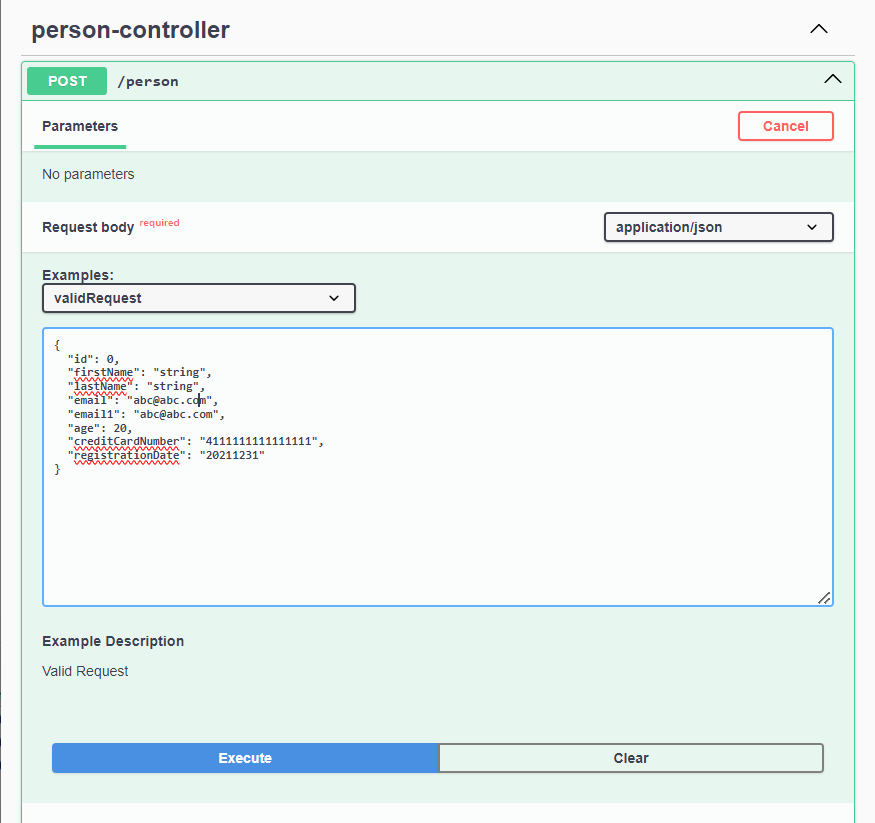
On pressing the blue Execute button, we see the below:
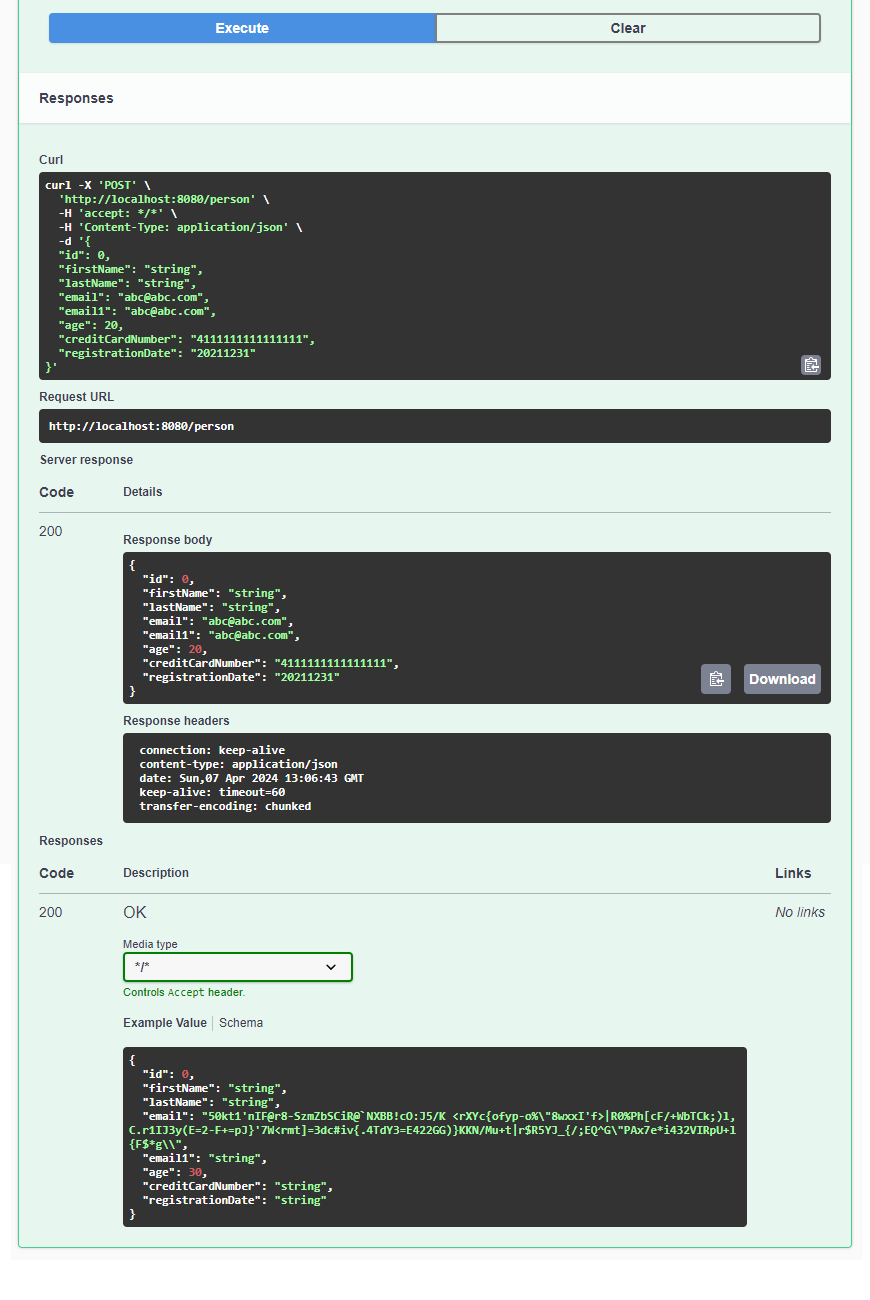
The code so far can be found here:
- Git Clone URL: branch: custom-validators-updated1
Let's revisit our objective:
New objective: Wouldn't it be nice if we could extend Swagger's behavior and communicate via its automated documentation the information regarding these additional annotations and also custom validation annotations?
Let's work on exactly this now.
Let's add two new classes.
package sample.config;
import lombok.AllArgsConstructor;
import lombok.Data;
@Data
@AllArgsConstructor
class DateTimeFormatData {
private String pattern;
private String dateTimeType;
}
package sample.config;
import java.lang.annotation.Annotation;
import java.util.Map;
import com.fasterxml.jackson.databind.ObjectMapper;
import io.swagger.v3.core.jackson.ModelResolver;
import io.swagger.v3.oas.models.media.Schema;
import sample.customvalidations.LocalDateTimeFormat;
import org.springframework.context.annotation.Configuration;
@Configuration
class CustomOpenApiValidator extends ModelResolver {
private final Class[] handledValidations = { jakarta.validation.constraints.NotNull.class,
jakarta.validation.constraints.NotBlank.class,
jakarta.validation.constraints.NotEmpty.class,
jakarta.validation.constraints.Min.class,
jakarta.validation.constraints.Max.class,
jakarta.validation.constraints.DecimalMin.class,
jakarta.validation.constraints.DecimalMax.class,
jakarta.validation.constraints.Pattern.class,
jakarta.validation.constraints.Size.class };
private final Package[] allowedPackages = { handledValidations[0].getPackage(),
org.hibernate.validator.constraints.CreditCardNumber.class.getPackage(),
LocalDateTimeFormat.class.getPackage() };
public CustomOpenApiValidator(ObjectMapper mapper) {
super(mapper);
}
@Override
protected void applyBeanValidatorAnnotations(Schema property, Annotation[] annotations, Schema parent, boolean applyNotNullAnnotations) {
super.applyBeanValidatorAnnotations(property, annotations, parent, applyNotNullAnnotations);
if (annotations != null) {
for (Annotation annotation : annotations) {
Class<? extends Annotation> annotationType = annotation.annotationType();
boolean handled = false;
for (Class check : handledValidations) {
if (annotationType == check) {
handled = true;
break;
}
}
if (!handled) {
Package annotationPackage = annotationType.getPackage();
boolean allowed = false;
for (Package allowedPackage : allowedPackages) {
if (allowedPackage == annotationPackage) {
allowed = true;
break;
}
}
if (allowed) {
Map extensions = property.getExtensions();
String extensionKey = "x-" + annotationType.getSimpleName();
if (!(extensions != null && extensions.containsKey(extensionKey))) {
Object value = describeAnnotation(annotation, annotationType);
property.addExtension(extensionKey, value);
}
}
}
}
}
}
private Object describeAnnotation(Annotation annotation, Class<? extends Annotation> annotationType) {
Object ret = true;
if (annotationType == LocalDateTimeFormat.class) {
LocalDateTimeFormat format = (LocalDateTimeFormat) annotation;
ret = new DateTimeFormatData(format.pattern(), format.dateTimeType().name());
}
return ret;
}
}
Please stop the application, then build and restart the application. Revisit the Swagger UI at http://localhost:8080/swagger-ui.html. If you check, you will find that the schemas now show the highlighted extensions to convey additional constraints.
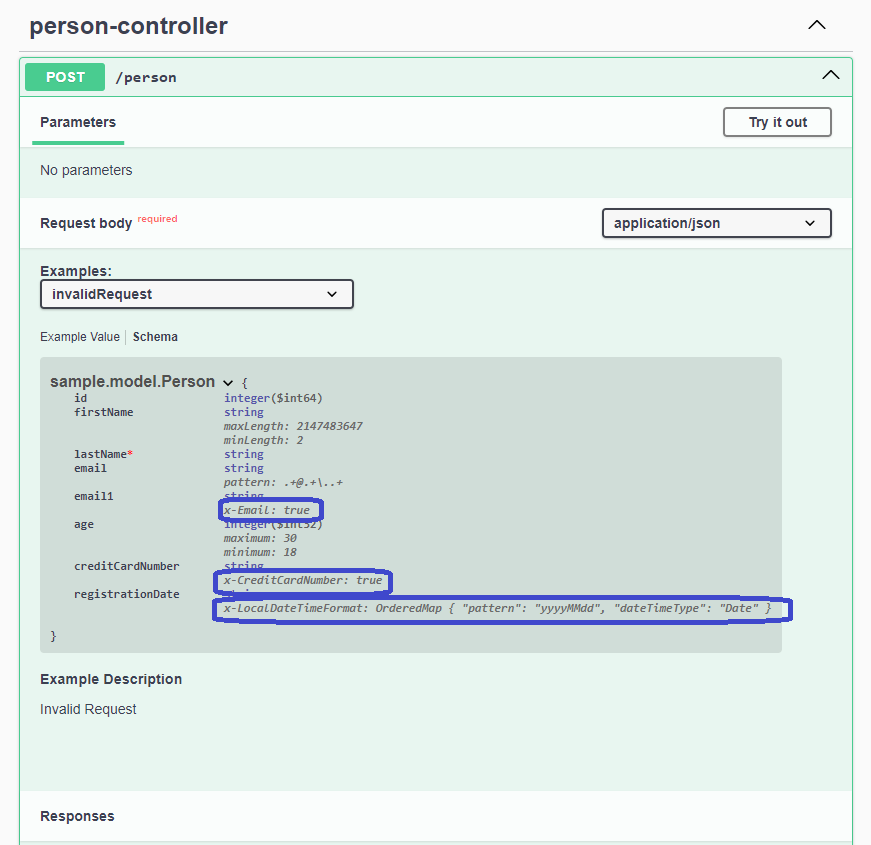
Also as shown below:
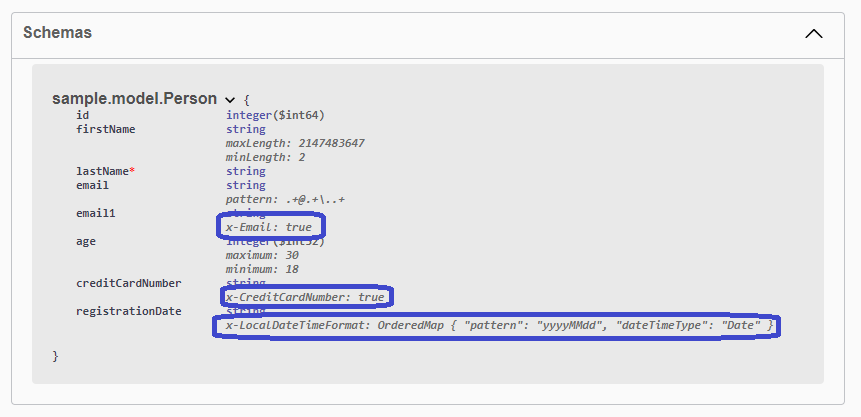
Conclusion
We have shown how to meet our new objective, demonstrated how to use Swagger schema extensions, and documented the additional constraints that would have otherwise remained undocumented. This includes custom validators. In the next part, we will try something along these same lines but stretch the limits a little more.
- Source code
- Git Clone URL, branch: documented-custom-validators-updated1
Troubleshooting Tips
- Ensure prerequisites.
- If using the Eclipse IDE, we might need to do a Maven update on the project (right-click on Project - Maven > Update Project) after creating all the files.
- In the Swagger UI, if you are unable to access the “Schema” definitions link, it might be because you need to come out of the “try it out “ mode. Click on one or two Cancel buttons that could be visible.
- Ensure you use http://localhost:8080/swagger-ui.html for this tutorial.
- Also, see Using Lombok for setting up Lombok in the IDE.
Opinions expressed by DZone contributors are their own.

Comments